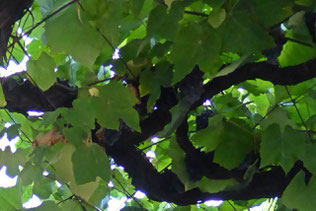
Portugal is known for its own fortified wine, port, and Porto is the centre of the port producing industry. A large area of land at Vila Nova de Gaia, on the opposite side of the Douro River from Porto, is dedicated to port wine production and is covered in the warehouses of several port cellars.
In this picture you can see the warehouses for Taylor's, Calem, Sandeman, Offley, and Cockburn's cellars. Their signs are all there, if you want to try to find them.
The grapes for the port wine are grown in the upper reaches of the Douro River valley, well upstream from Porto. The grapes are crushed there, and the port wine is produced there, but for the long term maturing humidity is required, so the port wine is brought down to Porto for maturation near the coast. These days the port wine is tranported using trucks, but traditionally it was transported with small sailing boats, so the Duoro river was an important transport artery, and the link it provides is part of the reason why the whole industry is here. These are some of the boats that were used for transporting the port wine:
You can see that the tiller on these boats is very long - it's more like a sweep oar. You can also see that there is a high platform for the helmsperson, which necessitates the long tiller. I expect this this is to give the helmsperson clear sight over the load of barrels, but it must make the boat hard to handle, and hard work to steer. These boats are now used to take tourists up and down the river to see the six bridges.
The grape crushing is quite a tourist attraction and activity in its own right: this is a picture of a picture in Taylor's port cellars, of people formally dancing in the crushed grapes.
I guess that the high level of alcohol in later stages of the process takes care of all the escaped toe jam!
We visited Taylor's Cellars in Vila Nova de Gaia. For €5 we were given tasting samples of three types of port wine and an informative walk through the cellars.
Briefly, this is how the process goes: initially the grapes are fermented as any other wine is. Before the fermentation process completes and consumes all of the sugar from the grapes a highly distilled, tastless and colourless form of brandy with an alcohol content of over seventy percent is added, which kills the yeast and stops the fermentation process. The resulting wine is them stored in oak barrels to mature.
The type of resulting port depends on how long the fermention stage is allowed to continue for; how long and in how large a barrel the maturation stage goes for, and whether or not the port is filtered. The types of resulting ports are white, ruby, tawny, and vintage.
These are some of the mid-sized casks at Taylor's cellars:
And these are some of the smaller ones:
My companions only wanted a sip of their port samples for literally a taste, so I finished their samples off for them, too, to avoid wasting it.
The port that I sampled was delicious; although, that assessment may be a result of drinking quite a few samples, being immersed in the dryly humorous presentation about how the port is made, and generally enjoying my visit to Porto. What do you think? Let me know in the comments, below!






Neville & Elea (Tuesday, 20 October 2015 11:38)
Neville (who is 103 years old) comments,"what an interesting experience - I'd like to have done that myself!" Neville also mentioned that the Douro River begins in Spain.
We have a street near us at Wellington Pt called Douro Road. The surveyor who named the street was obviously thinking about sipping port and floating down a certain river with his booty!